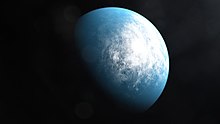TOI 700
| Observation data Epoch J2000 Equinox J2000 | |
|---|---|
| Constellation | Dorado[1][2] |
| Right ascension | 06h 28m 22.97s.[3] |
| Declination | −65° 34′ 43.01″.[3] |
| Apparent magnitude (V) | 13.10±0.01[4] |
| Characteristics | |
| Evolutionary stage | Main sequence |
| Spectral type | M2V[4] |
| Astrometry | |
| Radial velocity (Rv) | -4.4±0.1[4] km/s |
| Proper motion (μ) | RA: -102.750±0.051[5] mas/yr Dec.: 161.805±0.060[5] mas/yr |
| Parallax (π) | 32.0980 ± 0.0211[5] mas |
| Distance | 101.61 ± 0.07 ly (31.15 ± 0.02 pc) |
| Details | |
| Mass | 0.416 ± 0.010[4] M☉ |
| Radius | 0.420 ± 0.031[4] R☉ |
| Luminosity | 0.0233 ± 0.0011[4] L☉ |
| Surface gravity (log g) | 4.81 ± 0.06[4] cgs |
| Temperature | 3480 ± 135[4] K |
| Metallicity [Fe/H] | -0.07 ± 0.11[4] dex |
| Rotation | 54.0 ± 0.8[4] |
| Age | >1.5[4] Gyr |
| Other designations | |
TIC 150428135, UCAC3 49-21611, 2MASS J06282325-6534456, WISE J062823.05-653443.7, APASS 31812705, Gaia DR2 5284517766615492736 | |
| Database references | |
| SIMBAD | data |
| Extrasolar Planets Encyclopaedia | data |
TOI 700 is a red dwarf 101.4 light-years away from Earth[3][5] located in the Dorado constellation that hosts TOI 700 d, the first Earth-sized exoplanet in the habitable zone discovered by the Transiting Exoplanet Survey Satellite (TESS).[1][2][6]
Nomenclature and history[]
The acronym "TOI" refers to stars and exoplanets studied by TESS, and is short for: "Transiting Exoplanet Survey Satellite Object of Interest".
Stellar characteristics[]
TOI 700 is a red dwarf of spectral class M that is 40% the mass, 40% the radius and 55% of the temperature of the Sun.[6] The star is bright with low levels of stellar activity. Over the 11 sectors observed with TESS, the star does not show a single white-light flare. The low rotation rate is also an indicator of low stellar activity.[4]
Planetary system[]

Three exoplanets have been detected by TESS to be orbiting the host star TOI 700. All three exoplanets may be tidally locked to TOI 700.[6]
Three papers describe the validation of the planetary system, the follow-up observations of TOI 700 d with the Spitzer Space Telescope and the characterization of TOI 700 d.[4][7][8]
The composition of planets b and d is more likely rocky and the composition of planet c is more likely similar to that of Neptune.[4]
The two inner planets might have grown faster and accreted significant gaseous envelopes, but the outer planet formed more slowly and accreted less gas. The innermost planet may later have lost its envelope due to photoevaporation. Another scenario that could explain the arrangement of densities in this system is long-term planetary migration. Planet c might have migrated inwards, but this scenario is more plausible if future studies show that planet c is significantly more massive than planet b or d.[4]
TOI 700 d lies in the habitable zone. It receives 35 times more EUV photons than Earth, but also 50 times less than TRAPPIST-1 e. The host star has low stellar activity. The atmosphere of a planet with an Earth-like pressure would survive for longer than 1 Gyr.[4] Simulations of the planet have shown that TOI 700 d is a robust candidate for a habitable world. The simulated spectral feature depths from transmission spectra and the peak flux and variations from synthesized phase curves do not exceed 10 ppm. This will likely prohibit JWST from characterizing the atmosphere of TOI 700 d.[8]
In November 2021, a fourth possible planet, Earth-sized and receiving approximately 49% more flux than TOI-700 d from TOI-700, was found at the inner edge of the habitable zone of TOI-700.[9]
The system is near (but not in) orbital resonance: from planets b to d, period ratios are approximately 5:8, 4:7, 3:4.
| Companion (in order from star) |
Mass | Semimajor axis (AU) |
Orbital period (days) |
Eccentricity | Inclination | Radius |
|---|---|---|---|---|---|---|
| b | 1.07+0.80 −0.43 M |
